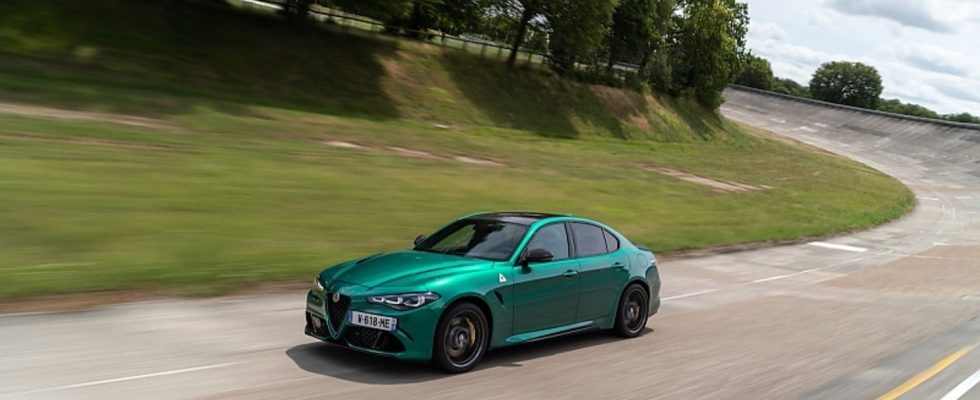Driving report: Alfa Romeo Giulia Quadrifoglio
Old school racing machine
Alfa Romeo Giulia Quadrifoglio 2023
© press-inform – the press office
Others are looking for salvation in rapid electrification, Alfa Romeo is taking a different approach: more emotions.
Old school racing machine
Of course, that’s not entirely healthy for the brand. “First of all, the issue is strongly driven by taxes,” explains Alfa Romeo product manager Daniel Guzzafame: “Where there are no strict restrictions on performance or emissions, the proportion is high – for example in Germany and the USA. Things are very different in Italy and France.” Nevertheless, it sounds as if the “normal” Giulia (from 55,500 euros) does not make it onto the shopping list of ordinary buyers in this country. “In the case of the Giulia, that’s actually something special,” admits Guzzafame: “When the vehicle was developed, we actually had passionate drivers in focus, for driving by definition. If you can afford it then you definitely want the V6.”
Despite – or perhaps because of – this unusual engine mix, the Giulia has unexpectedly slipped into the role of the long-distance runner. Launched in 2016, it still has to last until 2026. Only then, as Alfa Romeo CEO Jean-Philippe Imparato has announced, will there be a successor. This is said to deliver up to 1000 hp and will definitely be fully electric. “We also tested the possibility of electrifying the current Giulia,” reveals product expert Guzzafame: “Fully battery-electric is not realistic without destroying the agile character of the vehicle. And after studying our most important markets, plug-in hybrid technology was too inefficient for us.”
Since this spring, the Giulia has been enjoying a facelift that is not worth mentioning in terms of content. The Giulia Quadrifoglio is a little different. Here, too, there was not much intervention in the design, the equipment or the technical concept. Hardly anyone will perceive the car as “new” unless they are a hardcore fan who can recite all the product details inside out. But in keeping with the best motorsport philosophy, here too it is a list of little things that make the car better, in this specific case more aggressive. The increase in output of the V6 biturbo engine by ten to 520 hp is part of this. The speed-dependent alignment of the front splitter is one of those details that you don’t immediately notice in everyday use. The situation is completely different with the new mechanical locking differential. Of course, in the heavy traffic on the Brennero there is no sign of it. But alas, Giulia Quadrifoglio is let off the leash – maybe even on the racetrack.
The electronically controlled lock works extremely precisely and gives the rear-wheel drive sedan incredibly high traction. The differential lock provides additional grip when changing direction quickly, but especially when accelerating out of tight bends. Meanwhile, the motor control does not act as a spoilsport and reduces performance. The combination of both systems thus allows a certain degree of slip at the wheels, which allows a sensible degree of oversteer. This is fun for the driver, gives him security and makes the car incredibly agile. The maximum is achieved if you have switched to race mode beforehand – which should not be done on public roads due to the deactivation of numerous assistance systems. But even in dynamic mode, the Alfa is extremely light-footed thanks to the differential lock.
As much energy has gone into the drive setup and the new chassis tuning, so little has happened elsewhere: the size and placement of the central display is still from yesterday, as are the driver assistance systems. After all, the fittings cluster is fully digital and can be customized in many ways. The priorities at Alfa Romeo are obviously elsewhere: performance, handling and power-to-weight ratio. And in this respect, the Giulia Quadrifoglio is pleasingly classic: the 520 hp V6 sedan and the driver weigh 1,735 kilograms. In today’s world a really respectable value.

